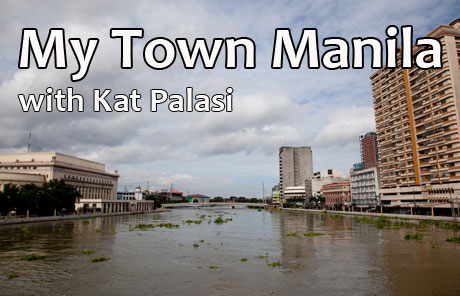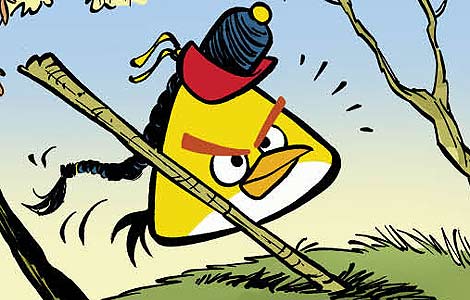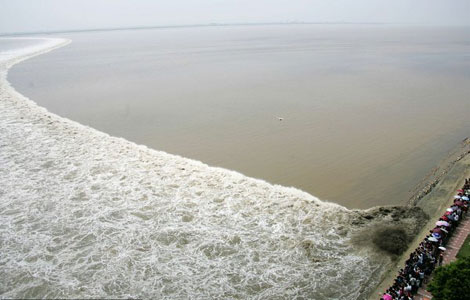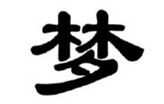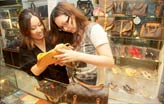Race back in time
Updated: 2011-09-16 08:55
By Yin Yin (China Daily)
|
|||||||||
|
|
|
|
Naadam Festival in Inner Mongolia brings 13th century activities to life
When Genghis Khan ruled most of the world, Mongolian men were required to have command of three special skills - horse racing, wrestling and archery. The sports were a way of judging a man's character and capabilities. This tradition continues during the Naadam Festival, which has just been held across the many grasslands of the Inner Mongolia autonomous region.
Naadam means entertainment or game in the Mongolian language, and this great annual pageant is held during the golden period of the year, between July and August, when the grass is the greenest and sheep and cattle are in peak condition.
The festival began in the beginning of the 13th century, and during the festival everybody took part in some way. Young and old would wear Mongolian long gowns, favoring red, yellow and blue costumes. In modern times, track and field, tug of war, basketball and volleyball have been added to the event.
Visitors to Inner Mongolia usually fly into the capital, Hohhot, which comes alive during Naadam. But one of the real festival hot spots is Xilin Gol League as well as Ordos, Siziwang Banner and Zhenglan Banner. When the festival is over, the activities can still be seen at special locations. Here is a closer look at some of the events a visitor can enjoy.
1. Horse racing
Mongolians have always regarded horses as sacred and for centuries they have relied on them, not only for transport, but also for companionship. Zhuri River Prairie in Horqin Left Wing Middle Banner is one of the best places to watch the races, where more than 1,000 horses can compete at the same time.
The races are divided into walking and galloping. For horse walking races, jockeys need to be highly skilled in order to rein in the horse and allow it to walk as fast as possible without allowing it to break into a gallop.
Galloping is all about speed and crossing the winning line first. Galloping horses are often not equipped with a saddle or only use a light and easy saddle, in order to reduce the weight. Riders always wear colorful uniforms and tie a red ribbon around their heads, which is a symbol of a rider's ambition to win.
2. Wrestling
Mongolian-style wrestling is different from Chinese wrestling and Japanese sumo in terms of uniforms, rules and methods.
The best matches can be seen at Zhenglan Banner, which is a district of Xilin Gol League. Xanadu used to be the summer capital of Kublai Khan during the Yuan Dynasty (1271-1368).
The wrestling field is small and is usually an area of lawn or soft space. The audience sits on the ground as wrestlers face each other in the middle.
The uniform is very special, made of cowhide or canvas. The jacket, called zhao de ge, is a skin-tight and has half-sleeves, and the pants are very loose.
Before the start of the competition, wrestlers slowly come up waving their hands imitating the flying phoenix. When wrestlers know who will face, after a signal, they converge in a fierce battle. The first one to fall down loses. The competition can last up to half an hour. Once the winner is decided, the wrestler then proudly waves his hands imitating an eagle.
Each wrestler has a title, for example, lion, falcon or elephant. It is a rank bestowed depending on the wrestler's past performance. The champion is awarded the title of Titan.
3. Archery
Ancient Mongolians, like others from all over the world, have been using bows and arrows for thousands of years. But the sport of archery originated from about the 11th century, during the period of Khanate. Archery is especially popular during Naadam.
As a rule, both men and women participate and every participant has nine arrows to shoot in three turns. The arrows, made from willow branches and eagle feathers, are shot at round, leather targets with grey, yellow and red rings.
The distance from the target to the archer depends on conditions, but it usually is a consistent location throughout a single competition.
There are two kinds of archery: shooting arrows standing still, or while riding a horse.
4. Dancing and singing
The festival ends with a big bonfire party at night and young people singing and dancing. Tourists are invited to sing and dance with the local people around the bonfire.
During the Naadam Festival, folk-style dancing and singing are performed on the grasslands of the host city. Male and female duets are an old romantic tradition of the Mongolian ethnic group.
There is still another distinctive part of the festival. It is the horse-head stringed instrument, a classic folk bowed instrument. Its features a wide body with a long neck, on the top of which is a carved horse head. The sound of this instrument is like a whimper but also melodious. Much of the music can imitate a horse, even the galloping horse while whinnying.
5. Special food
Now it's time to enjoy the pure flavors from the prairie. There are many local foods displayed in the herdsman's booth of each host region.
Ghee tea is a traditional drink of the Mongolian ethnic group. The taste is slightly salty and smells good. The Mongolia herdsmen prefer to use this tea to entertain guests.
Roasted whole lamb is the one must-try item when you are traveling the Inner Mongolia autonomous region. Its tender meat, golden oil and special flavoring tickles tourists' taste buds and satisfies their hunger.
Apart from farming and industry sideline products, there are a lot of other native products, such as beef and mutton, cheese, dried cheese, smoked meat, cream, milk curd and yogurt.



